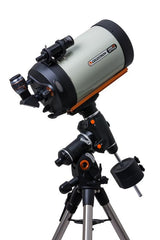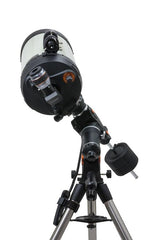CGEM II 1100 HD combines Celestron's newly redesigned CGEM II computerized equatorial mount with its acclaimed EdgeHD optical system. With an optical tube assembly weighing only 28 lbs., this telescope is still portable enough to be taken to dark skies, and has 89% more light gathering power than an 8" telescope and 40% more than the 9.25".
OPTICAL TUBE INFO:
See the Universe in HD
EdgeHD is an aplanatic, flat field Schmidt-Cassegrain telescope that produces aberration-free images across a wide visual and photographic field of view. The optical system was designed to reduce more than just off-axis star coma; it also provides an astrograph-quality flat focal plane all the way to the edge of the field of view.
True Astrograph Quality
Many optical designs that advertise themselves as "astrographs" actually only produce pinpoint stars across a curved focal plane. While this may be acceptable for some visual observing, stars will appear out of focus at the edge when used with the flat chip sensor of a digital camera. EdgeHD optics produce a focal plane more than three-times flatter than a standard Schmidt-Cassegrain telescope and dramatically flatter than competing coma-free designs. This guarantees you visibly sharp stars across some of the largest CCD chips available today. Learn more about EdgeHD technology.
Improved Performance
Superior edge performance not only creates rounder, more pleasing stars, but actually improves the resolution and limiting magnitude when compared to telescopes of equal aperture. With Celestron’s StarBright XLT optical coatings on every surface, EdgeHD optics gives you maximum light throughput across the widest visual and photographic spectrum.
Mechanical Features
In addition to EdgeHD’s optimized optical design, the telescope tube has been redesigned to make sure you get the most from your optics each and every night.
- Mirror clutches - Flexible tension clutches hold the mirror in place and reduce image shift when taking long exposure astro-images. Once focused, the flexible rods allow the mirror to be held in place without putting any force or pressure on the mirror assembly, keeping the image centered in the eyepiece (or on the sensor).
- Tube vents - Cooling vents located on the rear cell allow hot air to be released from behind the primary mirror. Each vent has an integrated 95-micron micromesh filter guaranteed to let warm air out without letting dust in.
- Fastar versatility - EdgeHD is the most versatile imaging telescope available today. At its native f/10, you can achieve the image scale necessary to capture the smallest of deep sky objects. Add the optional reducer lens—custom-designed for your size EdgeHD tube—and you can increase your field of view without sacrificing optical performance. A Barlow gives you added power for high-resolution planetary, lunar and solar imaging. All EdgeHD optical tubes are Fastar-compatible, allowing the secondary mirror to be removed and replaced with a third party lens accessory for ultra-fast f/2 wide field imaging.
Individually Tested
Every EdgeHD that ships has been tested not only for the surface quality of each optical component, but also with a camera and artificial star to ensure the imaging system meets our rigid quality assurance. This “final acceptance test” confirms the EdgeHD will perform in the field and deliver high-quality astroimages.
MOUNT INFO:
A fresh update to the venerable CGEM mount, the CGEM II has a fresh, attractive, bold appearance and is capable of carrying Celestron’s higher-end SCT optical tubes (up to 11") securely and vibration free, which is ideal for both imaging and visual observing. Capable of holding 40 lbs. of payload and slewing at 5° per second, you will be able to instantly point to any of the celestial objects in the database.
ERGONOMIC DESIGN
CGEM II was designed to be ergonomically friendly with large Altitude and Azimuth adjustment knobs for quick and easy polar alignment adjustment. The internal RA and DEC motor wiring provides a clean look and an easy and trouble free set up.
INNOVATION
The CGEM II series features Celestron’s innovative Polar alignment procedure called All-Star™. All-Star allows users to choose any bright star, while the software calculates and assists with polar alignment. Another great feature of the CGEM II sure to please astroimagers, is the Permanent Periodic Error Correction (PEC) which will allow users to train out the worm gears periodic errors, while the mount retains the PEC recordings.
PERFORMANCE
For objects near the Meridian (imaginary line passing from North to South), the CGEM II will track well past the Meridian for uninterrupted imaging through the most ideal part of the sky. The CGEM II mount has a robust database with over 40,000 objects, 100 user defined programmable objects and enhanced information on over 200 objects. Celestron's CGEM II mount is the perfect fit between the Advanced Series and CGE Series. Offering the portability of the Advanced Series and the precision of the CGE.
The EdgeHD optical system takes all of the compact power popularized by the SCT and combines it with an improved high definition optical system for wide field, astrograph quality images. As a visual instrument, EdgeHD optics deliver pinpoint images even with your widest field eyepiece. You can search for all of the Messier Catalog objects, and see hundreds of other equally interesting NGC, IC and Caldwell objects with amazing clarity. For astroimaging, the EdgeHD optics produce aberration-free images across your favorite CCD or DSLR camera. All EdgeHD optics are designed to produce an extremely flat focal plane precise enough to match the strict tolerances of the largest commercial CCD detectors, allowing all stars to be in tight focus to the very edge of the chip.
EdgeHD WhitepaperThe Celestron Product Development team has released a whitepaper outlining the technology behind EdgeHD. This paper describes the development goals, design decisions, optical performance, and their practical realization in 8-, 9.25-, 11-, and 14-inch apertures. We include cross-sections of the EdgeHD series, comparative spot diagrams for the EdgeHD and competing “coma-free” Schmidt-Cassegrain designs, a table with specifications for visual and imaging, graphics showing how to place sensors at the optimum back-focus distance, and details on the construction and testing of the EdgeHD telescope series.
Click here to download the whitepaper.
Diffraction Limited
Some companies boast that their telescopes give diffraction limited stars in the very center of the field of view. EdgeHD optics not only produce diffraction limited stars on axis, but maintain diffraction limited stars across the entire field of view of many of the most popular astrophotography cameras. Even at the very edge of a full frame camera chip, the EdgeHD 11" delivers star sizes of less than 2 arc seconds.
The EdgeHD 11" optics produce a focal plane three-times flatter than the standard equivalent SCT telescope with diffraction limited stars to the very edge of the Nikon 300 or Canon 40D sensor!

Along with the newly designed optics, the EdgeHD also has a re-designed optical tube guaranteed to help you get the maximum performance from your instrument.
Features Include:
Mirror Locks – To hold the mirror in place and reduce image shift during imaging.
Tube Vents - Each vent has an integrated 60 micron micro-mesh filter allowing hot air to be released from behind the primary mirror.
Fastar Versatility – All EdgeHD optical tubes are equipped with a removable secondary mirror for fast f/2 CCD imaging. Not only does imaging in the FASTAR configuration allow for exposure times that are 25 times faster than at f/10, but also yields a field of view five times wider. A perfect combination for imaging your favorite wide field objects in a fraction of the time. (FASTAR imaging requires a third party lens assembly in place of the secondary mirror).
Axiom Eyepiece - EdgeHD 11" optical tubes come with Celestron's top of the line Axiom eyepiece. With a 23 mm focal length and 82° AFOV you get an incredible combination of power and wide field of view. Plus each Axiom eyepiece is optimized to deliver pinpoint images when used with a flat field telescope.
Learn more about the benefits and features of this new optical system by going to the Edge HD web page.











